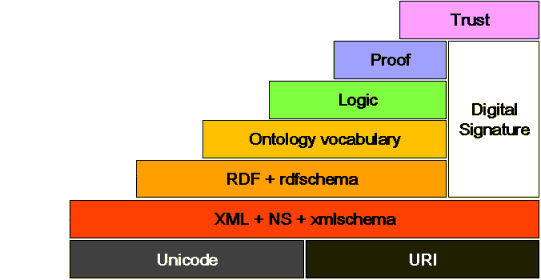Semantic web
Definition
- “The Semantic Web is a project that intends to create a universal medium for information exchange by putting documents with computer-processable meaning (semantics) on the World Wide Web.” Wikipedia: Semantic Web
Technology
People who work on the Semantic Web base their work on the famous "semantic web tower". Its major components are:
A simplified picture of the Semantic web tower is:
See also the RDF article, e.g. for information about the "RDF bus".
- Semantic web applications are usually built on top of RDF, e.g. see FOAF as a relatively simple example
Alternatively, there are initiatives outside the W3C RDF framework, like:
The relation to Web 2.0
Web 2.0 does incorporate some "semantics" but globally speaking it is much inspired by making it as simple as possible. E.g. Web 2.0 uses
- Simple RSS (0.91, 2.0) instead of more sophisticated RDF-based RSS 1.0
- Folksonomies instead of formal metadata taxnomies, based on RDF semantics.
- People-driven aggregation of knowledge (e.g. via syndication of the blogsphere) instead of smarter search engines. An exception are some of the best citation indexes that use both approaches.
In other words, Web 2.0 is not very smart, but it brought back people into the network (as planned some 40 years ago by Licklider and Taylor).
Some examples
- FOAF ("Friends of a friend") is an RDF-based social software for social networks.
- Semantic Media Wiki] (At some DSchneider will make a test with this within this wiki)
Discussion
Semantic Web is "heavy". At least today, it requires real programming skills (and that most of the php/javascript/mysql bricoleur community doesn't have, the writer of this sentence included).
Alternatives to the "official" vision of the semantic web are light-weight initiatives that can be found in some Web 2.0 applications and in initiatives like microformats.
Links
- Major Indexes
- Semantic Web. W3C home page. (includes links to all standards, groups, and some publications).
- Dave Beckett's Resource Description Framework (RDF) Resource Guide. This is probably the most complete index of documents.
- ontoworld.org - a "wiki for the Semantic Web community", includes news, events, etc.
- Short Tutorials etc.
- The Semantic Web Made Easy, W3C page, retrieved 16:10, 23 November 2006 (MET).
- FAQs
References
- Hendler, James, Berners-Lee, Tim and Miller, Eric "Integrating Applications on the Semantic Web," Journal of the Institute of Electrical Engineers of Japan, Vol 122(10), October, 2002, p. 676-680. HTML (Reprint).
- Horrocks, Ian; Bijan Parsia, Peter Patel-Schneider and James Hendler (2005). Semantic Web Architecture: Stack or Two Towers, in Francois Fages and Sylvain Soliman, editors, Principles and Practice of Semantic Web Reasoning (PPSWR 2005), number 3703 in LNCS, pages 37-41. SV, 2005. PDF Preprint
- Shadbolt, Nigel; Tim Berners-Lee and Wendy Hall (2006). The Semantic Web Revisited, by , IEEE Intelligent Systems 21(3) pp. 96-101, May/June 2006. PDF.
